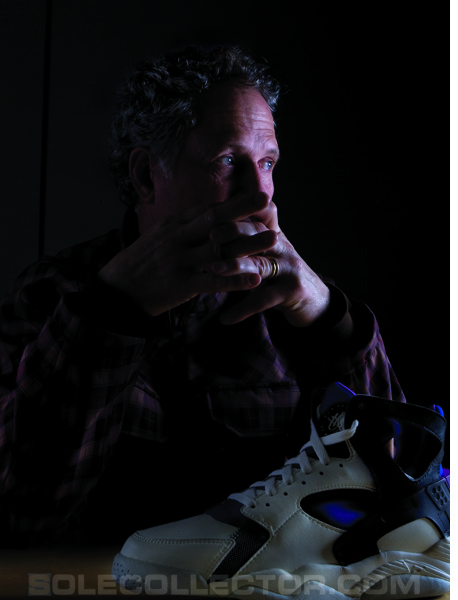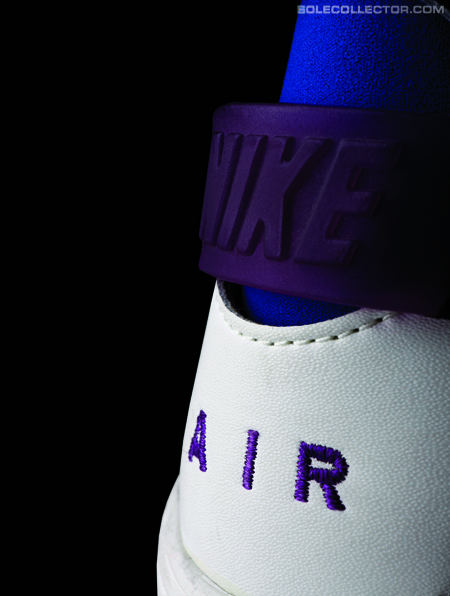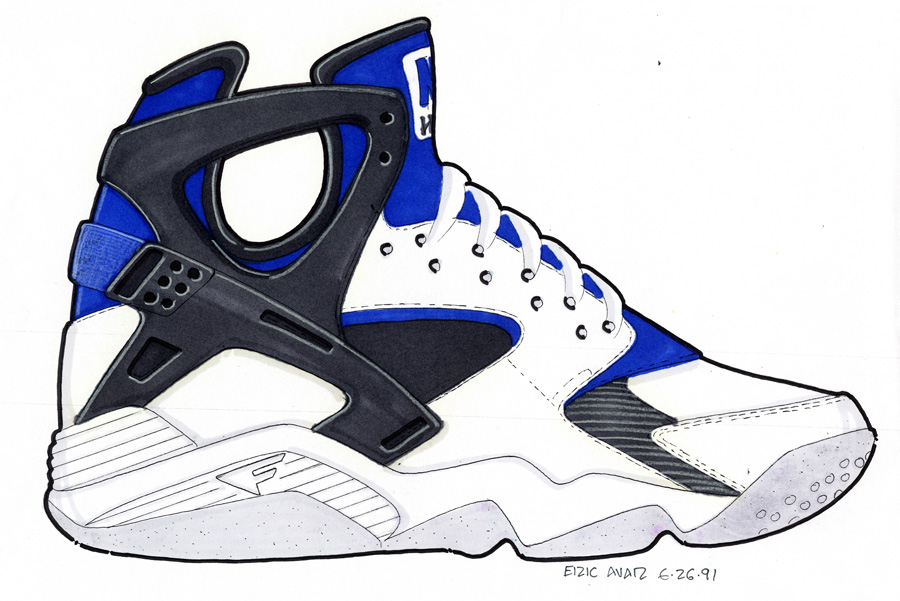
words & interview // Nick DePaula
As published in Sole Collector's Issue 26 : Available here.
It went on to be worn by the Fab 5 at Michigan, Kobe Bryant a decade later in LA, and, by extension, even Michael Jordan on his seventh signature model, but the idea of Huarache as a performance concept actually struggled to even initially get off the ground.
As the mastermind behind the fit solution, Tinker Hatfield recalls there was quite a bit of skepticism from nearly every branch of marketing that had a say. (If things were up to him then, they wouldn't have.)
Afterall, the early 1990s welcomed a world of overbuilt high-tops that promised both ankle support and sometimes even shin support. Surely Tinker's idea of actually stripping away panels surrounding the ankle bones didn't make any sense at all.
Enjoy a firsthand account straight from the concept's original creator, as Tinker reflects below about how the entire Huarache series almost never was...
As told by Tinker Hatfield //
So the Huarache concept came out of a singular experience I had. This doesn't always happen this way. But I was water-skiing one day, and I was sitting in the water slalom skiing. Both feet were actually in these neoprene booties, and you're strapped in.
 So I'm getting ready to get pulled out of the water, and I got yanked up and either the boat wasn't going fast enough or I wasn't doing something right, but I crashed. So I'm sitting there, waiting to get pulled up again, and I'm looking down, and I'm just kind of waiting, and I'm looking at how these neoprene booties sort of fit nicely around [my feet].
So I'm getting ready to get pulled out of the water, and I got yanked up and either the boat wasn't going fast enough or I wasn't doing something right, but I crashed. So I'm sitting there, waiting to get pulled up again, and I'm looking down, and I'm just kind of waiting, and I'm looking at how these neoprene booties sort of fit nicely around [my feet].
They just sort of conform around anybody's ankle. The neoprene bootie in a water ski fits a bunch of different people, so I'm thinking, "That's kind of cool," and then ... whup! [laughs] In the middle of that thought, all of a sudden I'm skiing again. [laughs]. So afterwards, I skied on, and then I got out of the water, and I was just looking at the booties, and I'm just going, "That's one of the problems we have with shoes, they don't really conform to different shapes of feet very well," and I said, "Neoprene does that."
I went back to my studio a couple days later and started sketching up neoprene-based shoes. A lot of people think that Huarache comes from the Sock Racer, but it doesn't come from the Sock Racer at all. The Sock Racer was stretchy [in the forefoot], and I'm going, "That's not really where you want stretch." You want stretch to be [along the collar] where your feet are all different shapes. You want it to fit better [at the collar], that's where shoes should fit better, right there.
So I started sketching up booties and then realized that it needed, for support, some sort of exoskeleton, because I thought it would be cool to be seen. So the whole exoskeletal approach to the shoe design sort of came out of this sort of desire to want to develop this Dynamic Fit shoe. In some ways I guess you could say it has an internal bootie. It's not really internal; you see most of it in this or in the original running shoe.
I started drawing this exoskeleton over it, and I took it into Sandy Bodecker's office, this first sketch, and it's in archives. We actually have it. The first sketch sort of showed this neoprene idea with this exoskeleton over it and Sandy, he thought it was really cool, and in a red pen he just wrote, "Sneaker of the Gods." Like it looked like something that Zeus would wear, like a sandal, kind of like a sandal. I was not thinking sandal or Huarache or anything at the time, it was Sandy who wrote "Sneaker of the Gods" and [he was] kind of thinking, "Yeah, this is what Zeus would wear or Mercury or somebody."
So I came back, I'm going, "It's sort of like a sandal." And then I'm going, "I don't want to call it a foot sandal or a something." So a lot of us had been to Mexico, and I'm thinking, "Instead of calling it a sandal, I'll call it a Huarache." So that's how the whole thing got started.
The idea was interesting in that it focused on the fit of the shoe around your ankle and your heel and your instep rather than sort of being stretchy and conforming up in the toes.
Sock Racers always make my toes go numb, so the last thing I wanted to do was create another one of those, because the stretchiness was pulling on my toenails, and it just made my toes feel funny. This was a minimalist concept of what we called conforming, or in our case, we called it Dynamic Fit with the exoskeletal support system. We didn't need a heel counter, and then we combined it with this sort of cupping.
As I was finishing up the running shoe, which, by the way, was developed by Michael Donohue, and Sandy Bodecker got involved, and Mike Quinn got involved ... some of our very best people today were some of our very best people way back, in a different role. Quickly we realized that this had more legs than just being in a running shoe.

So, I thought, "Well, I'll just sort of take this same idea, and transfer it into both a cross training shoe and a basketball shoe." Kind of the big three at the time: running, cross training and basketball. I did this sketch [for cross training] that pretty much mimicked the running shoe. It was very similar, but with an extra strap for the upper to go up higher in a hi-top silhouette and then a deeper, bigger midsole cradle and then, of course, the rubber was different than we would have on our running shoe.
 My recollection is that I had this sketch, the original sketch of the basketball shoe, and I handed that off to Eric Avar. And he was still pretty young at the time, so it was just sort of given to him to finish it all off. So he finished his design, put in some of the other little details, and he did the outsole, too. I didn't do that particular outsole. He took it to its conclusion and that was because I was busy working on the cross trainer. He was doing this one, and the running shoe was kind of just up and rolling. So that's really how it got sort of birthed.
My recollection is that I had this sketch, the original sketch of the basketball shoe, and I handed that off to Eric Avar. And he was still pretty young at the time, so it was just sort of given to him to finish it all off. So he finished his design, put in some of the other little details, and he did the outsole, too. I didn't do that particular outsole. He took it to its conclusion and that was because I was busy working on the cross trainer. He was doing this one, and the running shoe was kind of just up and rolling. So that's really how it got sort of birthed.
The running shoe, by the way, it didn't book at all, the original Huarache shoe, it did not book. It was going to die. Only 50 pairs were booked by maybe only one store. I remember Tom Parks saying, "You know, it's just a niche product, [we] probably shouldn't even make it." Tom Archie believed in that running shoe so much that he ordered 5,000 pairs, and he didn't even have the authority to. He was the PLM for running, and he ordered 5,000 pairs without bookings, which Nike, at least then, never would have done. He just did it anyway, which is awesome.
That was so cool. Then, he was kind of in a sense on the hook for these 5,000 pairs. [laughs] He took them to the New York Marathon, put them in our booth at the New York Marathon, and started selling them. He sold them all, and people were putting them on, and it was one of those rare products that looked different, but when you put it on it also felt different and felt different for the better because it sort of fit in a new and more conforming way, and going back to the water ski analogy, it sort of just conformed to your particular shape, and it was interesting. Now there're 5,000 pairs out there, and the orders just start rolling in. And then the rest is history for that running shoe that, I think, at the end of that first year had sold 250,000 pairs.
So, we were probably a little more able then to change and ramp up production than we are today just because of the way factories were a little looser. So they were able to ramp up production and get more shoes into the marketplace, and then the design stayed around. They kept it for the following year or two maybe. In the meantime, what was cool about the basketball shoe was that the Fab 5 at the University of Michigan were given these shoes, and they all wore them. They thought they were great. This shoe developed a life of its own partly because there was no basketball shoe that ever looked like that before it, and these guys all at the University of Michigan were all wearing them. Again, it was an explosion after that. That's how I remember the story...

